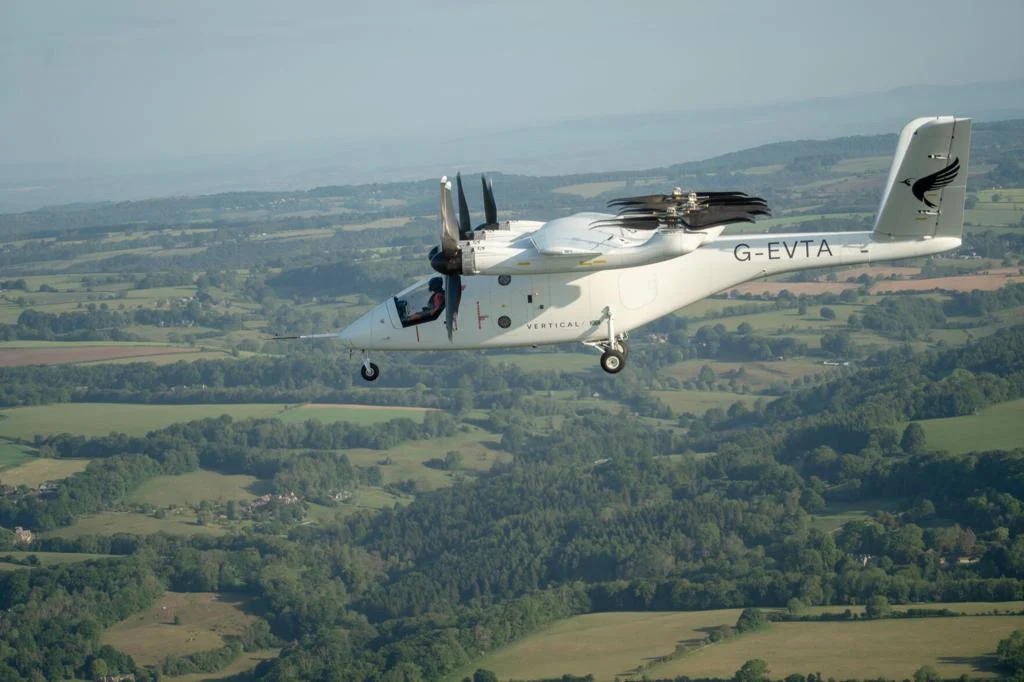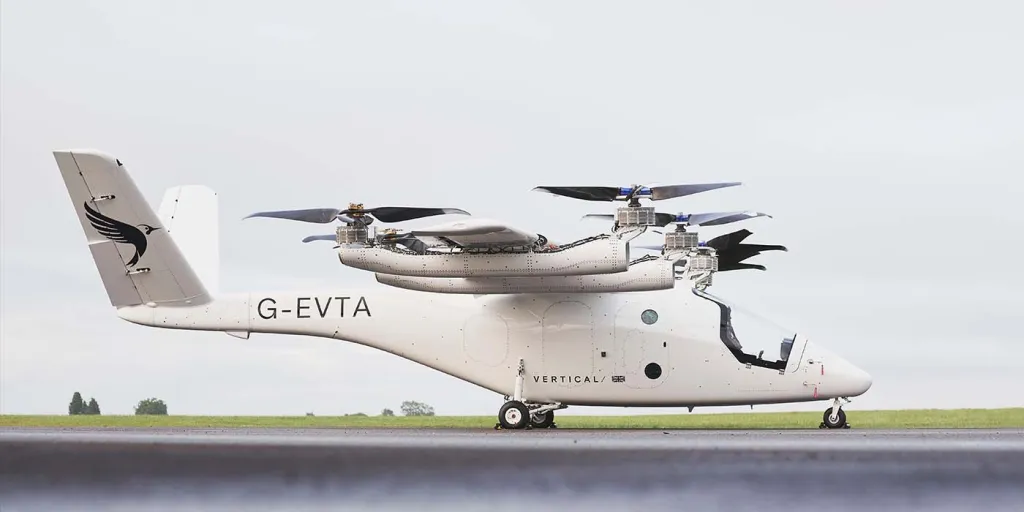
Vertical Aerospace Flies into History with First Piloted eVTOL in Open Airspace
Vertical Aerospace , a leading global aerospace and technology company at the forefront of electric aviation, has officially marked a historic milestone in European aerospace. The company announced that it has successfully completed the first-ever piloted wingborne flight of a winged electric vertical take-off and landing (eVTOL) aircraft in open airspace—an achievement that signals a pivotal moment in the path toward commercial electric aviation.
This groundbreaking flight, carried out by Vertical’s VX4 prototype, was piloted by the company’s Chief Test Pilot, Simon Davies. The aircraft took off, transitioned to wingborne cruise flight, and then landed at Cotswold Airport—demonstrating controlled flight behavior and operational capability in real-world, unrestricted airspace. This event represents the first instance of a winged eVTOL being flown by a human pilot under actual flight conditions in open skies, rather than in the more controlled environment of an airport test zone.
The UK Civil Aviation Authority (CAA) granted approval for the flight by extending Vertical’s existing Permit to Fly, following a comprehensive and rigorous assessment process. This included an in-depth review of thousands of pages of safety, engineering, and flight readiness documentation, ensuring the flight adhered to the highest standards of operational safety.
A Defining Moment in the Evolution of Electric Aviation
Simon Davies, who helmed the flight, described the experience as both professionally rewarding and technically reassuring. “Taking the aircraft beyond the airfield and cruising over the Cotswolds for the first time was truly special and a career highlight for me,” Davies said. “Our performance predictions were absolutely spot on. The VX4 flew exactly as we expected, behaving like a natural extension of all the ground tests we’ve meticulously carried out. The aircraft was not only safe and capable—it was a genuine pleasure to fly. It’s smooth, responsive, and remarkably quiet in the cockpit. Flying it was an honor and a testament to the entire Vertical team.”
The VX4 is currently the only piloted, winged eVTOL aircraft being flown under a Design Organisation Approval (DOA) granted by the UK CAA. DOA status is a critical certification designation, required before an aircraft manufacturer can obtain a Type Certificate, which is essential for commercial passenger flight authorization. Vertical’s collaboration with the CAA also includes a concurrent validation process with the European Union Aviation Safety Agency (EASA), ensuring the VX4 meets the strictest standards set for commercial aviation across Europe.
Vertical’s Strategy and the Road to Certification
This successful flight is a critical step within Vertical’s broader Flightpath 2030 strategy—a roadmap designed to guide the company toward full certification and entry into commercial service within the decade. Stuart Simpson, CEO of Vertical Aerospace, highlighted the strategic importance of integrating human-piloted flights early in the development cycle.
“Achieving piloted wingborne flight in open airspace under the rigorous oversight of the UK CAA represents a vital inflection point in our certification journey,” Simpson stated. “The UK’s regulatory framework is exceptionally robust—every stage of the process requires explicit approval, which ultimately strengthens the safety and credibility of our program. It’s like undergoing a mini-certification for each flight milestone, bringing us measurably closer to full type certification.”
Simpson further emphasized the value of real-world piloted testing. “Choosing to place a pilot in the VX4 at this stage was a deliberate and strategic decision. Simulations and unmanned flights offer invaluable insights, but nothing compares to the qualitative feedback and data gathered from an experienced pilot in actual flight conditions. This milestone not only proves the capability of our aircraft, but also underscores the maturity and readiness of our program as we move toward commercial operations.”
Propelling the UK Aerospace Industry Forward
This aviation milestone has been bolstered by critical support from the UK government through early-stage funding and innovation programs, including the Aerospace Technology Institute and the Future Flight Challenge. These initiatives are part of the UK’s broader commitment to building a sustainable and technologically advanced aerospace sector, while also accelerating the country’s path to net-zero emissions.
Jonathan Reynolds, UK Secretary of State for Business and Trade, commented on the broader implications of the flight: “This is a fantastic milestone for Vertical and a proud moment for the UK’s world-class aerospace sector. Breakthroughs like this are made possible by strategic collaboration between government and industry. Our modern Industrial Strategy will continue to build on this success, ensuring that investors have the confidence to support UK manufacturing and innovation for the long term. This flight is not just a technological triumph—it’s a signal of green growth and quality jobs to come.”
The Importance of Wingborne Flight Capability
The flight marked the VX4’s entry into Phase 3 of its flight test campaign—wingborne flight. In this configuration, the aircraft generates lift from its wings, much like a traditional fixed-wing aircraft, rather than depending solely on rotor thrust as it would during vertical take-off and landing.
This phase is significant for several reasons. Wingborne flight is more energy-efficient, quieter, and capable of covering longer distances, making it critical for the commercial viability of electric air taxis. Operating in this mode allows for reduced power consumption and noise pollution, addressing two of the most prominent challenges facing urban air mobility solutions.
Jim Currier, President and CEO of Honeywell Aerospace Technologies, one of Vertical’s key partners, acknowledged the importance of the milestone. “This achievement showcases what’s possible when advanced avionics and innovative aircraft design come together. We’re proud that Honeywell’s Anthem flight control computers and software played a critical role in supporting Vertical’s flight program and enabling this landmark moment for the aerospace industry.”

David Stepanek, EVP and Chief Transformation Officer at Bristow Group, echoed that sentiment. “The VX4’s successful demonstration of wingborne flight brings us a step closer to realizing the full commercial potential of electric vertical lift. As leaders in sustainable aviation solutions, we are excited to continue our partnership with Vertical and look forward to the VX4 revolutionizing short-haul mobility.”
Jill Blickstein, Vice President of Sustainability at American Airlines, one of Vertical’s launch customers, added: “This achievement is a key milestone on the path toward electrified aviation. Sustainable flight is central to the future of our industry, and we are proud to support Vertical’s ongoing progress.”
Data-Driven Progress Toward Transition Flight
The next critical milestone for the VX4 is the full piloted transition flight, anticipated in the second half of 2025. This event will demonstrate the aircraft’s ability to smoothly transition between vertical lift and forward cruise—a fundamental requirement for operational air taxi services.
During its recent flight, the VX4 reached speeds of up to 150 mph (approximately 120 knots) and altitudes approaching 2,000 feet. Engineers collected more than 30,000 flight data parameters, which confirmed excellent performance across multiple areas, including stability, control, and energy efficiency.
A Foundation Built on Rigorous Testing
Vertical Aerospace’s readiness for wingborne flight was grounded in a foundation of extensive lab, simulation, and ground testing, including:
- Over 7.2 million fatigue cycles on each propeller blade to simulate cumulative in-flight loads across the aircraft’s expected lifespan.
- A 15.2-meter drop test of the battery pack—designed to mirror fuel tank crashworthiness standards in traditional rotorcraft.
- A full-scale thermal runaway propagation test on a VX4 battery sub-pack, proving that safe flight and landing are achievable even in the event of a fire.
- More than 3,000 hours of flight control software and integration testing to ensure system reliability and redundancy.
The successful piloted wingborne flight of the VX4 is not merely a technical accomplishment—it is a harbinger of the next era in aviation. As Vertical Aerospace continues advancing toward full certification and commercial launch, its achievements are laying the groundwork for a sustainable, efficient, and scalable model of urban air mobility.
With strong regulatory partnerships, strategic industry alliances, and steadfast investor support, Vertical is leading the charge in transforming air travel for the 21st century.

